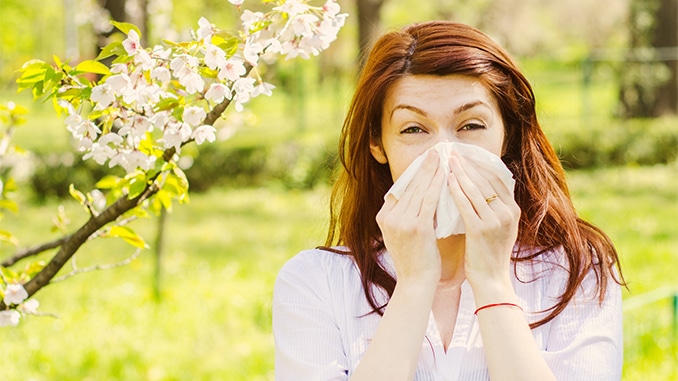
It’s not your imagination — allergies are getting worse. CBS News reported last year that because of climate change, trees are starting to produce pollen earlier than usual as well as in higher amounts than usual. Flowers and grass are also starting earlier, with ragweed pollen lasting longer into the fall.

In the eastern part of the United States, pollen counts increased earlier with impacts felt for a longer period in 2017. In the mid-Atlantic and Ohio Valley, allergies also started earlier, with Colorado reporting a steady increase in tree pollen in recent years. Because of early rains in 2017, California noted tree pollen counts three times higher than they were in 2016.
National Geographic reported in 2016 that as plants are exposed to warmer temperatures and higher levels of carbon dioxide, they grow more vigorously and produce more pollen than normal. In a 2012 study, researchers predicted that pollen counts could double by the year 2040.
That means that if you suffer from spring allergies, they’re not going to go away anytime soon and are more likely to get worse or at least to bug you for longer than they used to. Thousands of people are looking for solutions, and we’ve got several for you below.
3 Lifestyle Tips to Help You Manage Spring Allergies
First, start by taking the following steps to reduce your exposure to allergens and to help clean them out of your sinuses and your home.
1. Rinse Out the Allergens
Tips for Managing Spring Allergies: As you go about your day, your nostrils can inhale pollen and other allergy triggers and then trap them there, where they can continue to cause symptoms. Flushing these allergens out is an easy, natural way to help reduce your symptoms.
You can go about this in two ways:
- Use a saline rinse: You can buy a simple saline nose spray, and then use it as needed. Blow your nose first, shake the bottle a few times, exhale, place the bottle into one nostril and aim it toward the back of your head. Hold the other nostril closed with your finger. As you squeeze the bottle to spray, inhale slowly. Then, repeat on the other side. Try not to blow your nose for a few minutes afterward.
- Use a neti pot: Using distilled water (never tap water as it can carry parasites) and non-iodized salt, if desired. Never use table salt — find salts specifically for Neti pots. Warm the water slightly and mix it with the salt to create a rinsing solution. Bend over the sink, turn your head to the side, insert the pot’s spout into the upper nostril and raise it, so the solution flows into the upper nostril and out the lower one. Breathe through your mouth as you do this.
Either of these rinses can help keep allergens out of your system.
2. Avoid Going Out on Strong Pollen Days
Tips for Managing Spring Allergies: You can find pollen counts in your area by checking Pollen.com. Input your ZIP code, and you’ll get the current allergy report of the day. On those days when the readings come back high, consider staying indoors or at least avoid going out at midday, when pollen counts are usually highest. Windy days are also more likely to stir up your allergies, so keep windows closed on those days.
3. Change Clothes When You Get Home
Pollen can remain on your clothes when you come in from the outdoors, and if you wear those clothes around the house, you could contaminate your living area and destroy your one allergy sanctuary. Always change clothes when you get home, and store the dirty clothes in a hamper or wash them right away. It also helps to vacuum regularly, and you may want to invest in a high-efficiency particulate air (HEPA) filter to help keep your home allergen-free.
7 Natural Ways to Reduce Allergy Symptoms
In addition to the lifestyle tips above, you can also use several natural herbs and vitamins to help tame your allergy symptoms. Some of the most effective are listed below.
1. Quercetin
Tips for Managing Spring Allergies: If you regularly eat dark leafy greens, broccoli, onions and berries, you already get some quercetin. This is a type of antioxidant that helps give plants their color. It naturally fights damaging free radicals in your body, and is a natural anti-inflammatory. Studies have also found that quercetin, when taken in supplement form, may help to relieve allergy symptoms.
In test tube studies, scientists found that quercetin stopped the release of histamine. The body releases histamine in response to an allergen. It is histamine that causes allergy symptoms like sneezing and itchy, watery eyes. Quercetin worked like an antihistamine.
In a 2016 study, researchers also reported that quercetin had other anti-allergic properties, including an ability to not only inhibit the release of histamine but also decrease the release of other cells that cause inflammation. The researchers suggested that quercetin could be used in asthma responses and allergic rhinitis.
You can eat more foods with quercetin, but during the spring allergy season, you may fare better if you take a supplement. The typical dose is 500mg to 1,000mg per day. If you take a blood thinner like warfarin or apixaban, check with your doctor before taking quercetin supplements as it could elevate bleeding risk.
2. Butterbur
How about a natural herb that’s as effective as over-the-counter allergy pills? That may be butterbur. Scientists found in one study of 125 people with hay fever that butterbur was as effective as cetirizine. Another small study found that it worked just as well as fexofenadine.
Native to Europe and parts of Asia and North America, butterbur grows in wet, marshy ground and has large leaves. If you get headaches with your allergy symptoms, this may also be the herb for you. In a series of three studies, researchers found that butterbur helped reduce the frequency and severity of migraine headaches. Researchers think it’s effective because it naturally reduces inflammation.
There is some concern that taking butterbur long-term could cause liver injury, but this is only if you take a low-quality product that may contain toxins. Look for a high-quality supplement. Petadolex, the brand of butterbur extract most studied for migraine prevention, is considered significantly effective. Try a supplement of 100mg to 150 mg per day. It may take up to three months to see effects.
3. Nettle Leaf
Tips for Managing Spring Allergies: Also called “stinging nettle,” nettle leaf is not something you want to encounter in the wild. It has fine hairs on its leaves and stems that can sting you if you touch them. When prepared and taken internally, however, this herb can have many health benefits, and one of them is relieving allergy symptoms. In fact, the herb has been used for thousands of years for that very purpose.
Although it doesn’t have as many studies behind it as quercetin and butterbur, there is one small study that showed 57 percent of participants achieved allergy relief with nettle. Nearly half also stated that it was more effective than allergy medications. Nettle seems to work like quercetin does, helping to stop the release of histamine.
Nettle won’t hurt you in an extract, tea or tincture, so you can take it however you like. Studies found that an effective dose was about 600mg per day while needed. Check with your doctor first — the supplement can interact with high blood pressure, diabetes and other heart disease medications.
4. Spirulina
This is a blue-green algae that is considered to be one of the oldest life forms on earth. It contains about 50 to 70 percent protein as well as vitamin B12, calcium and many other nutrients, including eight essential amino acids and powerful antioxidants.
Studies have found that this algae also works on the immune system, helping to increase resistance to allergic reactions. We know that the reason we suffer from allergies in the first place is that the immune system makes a mistake. It sees an allergen as an “invader” and attacks it, releasing the histamine that causes symptoms. Spirulina has been found in studies to affect the immune system in such a way that it doesn’t react so violently, thus reducing stuffy nose, sneezing and watery eyes.
In one 2008 study, for instance, researchers found that spirulina helped reduce nasal congestion, itching and sneezing. Be sure to look for quality products as contaminated spirulina can cause adverse side effects. A typical daily dose is about 2,000mg to 3,000mg, broken up into 500mg at a time.
5. Feverfew
Tips for Managing Spring Allergies: Feverfew is a short perennial that is a member of the daisy family. Most supplements are made with dried feverfew leaves. Like butterbur, feverfew has also been found in studies to be effective against migraine headaches. Those who took feverfew had fewer migraines that were less severe than those who didn’t.
If you suffer from skin allergies like dermatitis during allergy season, feverfew may be able to help with that too. Moreover, early studies have found that it can reduce damaged skin cells and inflammation, improving the appearance of skin. The natural anti-inflammatory effect may also help reduce allergy swelling and hives. Try about 50mg to 250mg per day while needed.
6. Astragalus
Tips for Managing Spring Allergies: We don’t have as much scientific evidence on this one as some of the others when it comes to allergies, but there was one placebo-controlled, double-blind study that showed that astragalus had a beneficial effect on seasonal allergy symptoms. Furthermore, researchers recruited 48 adults with moderate to severe allergies and gave them a supplement containing astragalus extract. They found that the participants experienced an improvement in nasal symptoms.
Astragalus also has natural anti-inflammatory properties that may help people with asthma. Animal studies have found that it reduced the tendency of the airways to swell up and close, and it also reduced the production of mucus. One human study found that it could improve the efficacy of steroids when given to children with asthma.
The root is the part of the plant most used and is said to help protect the body against stress. Some modern research has also suggested it may help boost the immune system. Moreover, try 250mg to 500mg daily of root extract or astragalus tea.
7. Probiotics
You already know that probiotics can help ease digestion and repopulate your gut microflora. Probiotics are “friendly” bacteria that seem to provide several health benefits, including boosting the immune system and helping to maintain a healthy brain-gut connection, which can stabilize mood.
Some studies have also indicated that if you take probiotics, you may also help relieve your allergy symptoms. In 2013, for example, researchers reported that probiotics were useful against allergic rhinitis (sinus symptoms). In 2017, they split about 170 adults with allergies into two groups: one received a combination probiotic, and the other received a placebo. Those who took the probiotics reported improvements in allergy-related nasal symptoms and quality of life.
You can get more probiotics into your diet by eating more fermented foods, including yogurt, kefir, miso soup and kombucha. During allergy season, a combination probiotic supplement may work better.
For healthy recipes to make this your best Spring yet, pick up your free copy of our Spring Cookbook, here!





